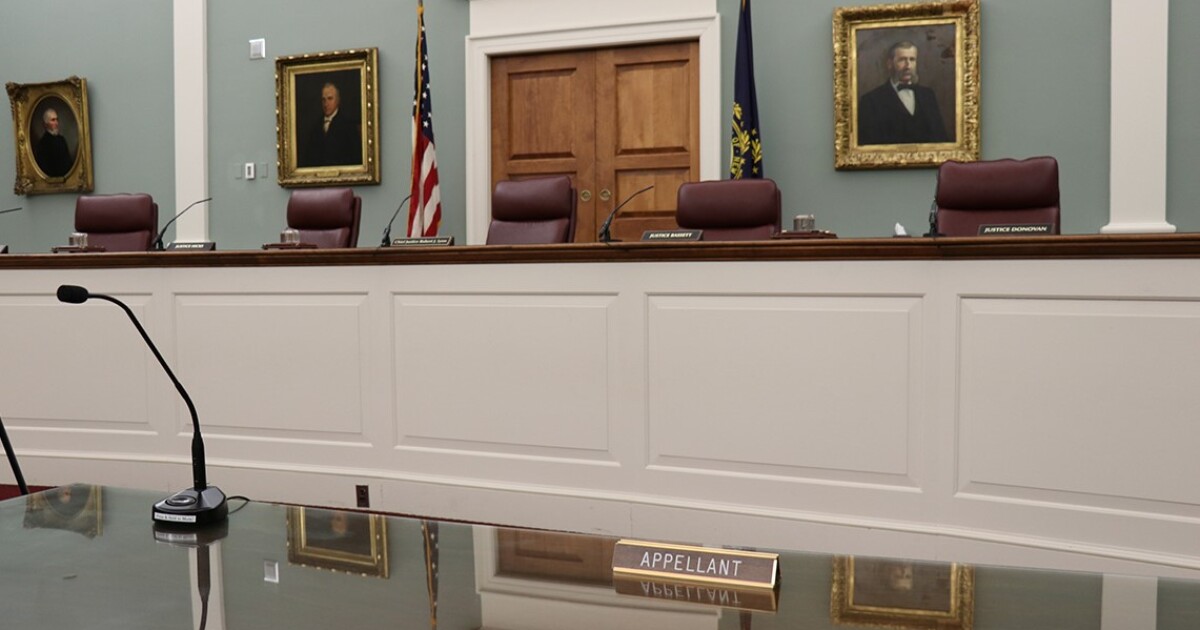The New Hampshire Department of Justice is scrutinizing a series of personnel maneuvers that allowed a Judicial Branch employee with close ties to the chief justice of the state Supreme Court to collect nearly $50,000 in employment benefits following a 48-hour layoff.
On Oct. 27, a top state prosecutor sent letters to an attorney representing Chief Justice Gordon MacDonald, as well as to the top administrative judge for the state judiciary, telling them to preserve records related to the employment of Dianne Martin. Meanwhile, MacDonald has hired Jane Young — his former deputy when he served as New Hampshire Attorney General and a former U.S. attorney — to represent him in the state’s inquiry.
In addition to contacting the chief justice, the Department of Justice has sent similar preservation letters to Martin, and to Charlie Arlinghaus, the commissioner of the agency that processes payroll for state employees.
In April, Martin was laid off from her position as an administrative director at the state Judicial Branch, but was then rehired two days later into another high-paying job. The brief gap in employment, which was detailed in an investigation published last month by NHPR, allowed her to cash out her accrued employment benefits, including unused vacation and sick time. Martin would not have been able to collect the benefits if she had been transferred directly into the new position, according to state personnel rules.
Martin was previously MacDonald’s chief of staff when he served as New Hampshire attorney general, and she followed her former boss to the Judicial Branch when he became chief justice. According to a whistleblower who raised concerns about the transaction, Martin requested the brief layoff in order to collect the benefits, and was aided by MacDonald.
NHPR obtained the preservation letters, which were sent four days after NHPR’s initial report on Martin’s moves was published, through a public records request. The letters instruct the recipients to not destroy any emails, text messages, voicemails or other correspondence related to Martin’s removal as director of the Administrative Office of the Courts, and her subsequent hiring as a general counsel in the Judicial Branch.
Letter sent by the NH Department of Justice to Chief Justice MacDonald, via his attorney
The letter send by the New Hampshire Department of Justice to the attorney representing Chief Justice Gordon MacDonald, dated Oct. 27, 2025.
Preservation letters are used by parties in legal proceedings to ensure that possible evidence is not destroyed.
“To be clear, this is strictly a preliminary review, and no formal criminal investigation has been opened,” Deputy Attorney General James Boffetti wrote in the letters.
Even before Boffetti alerted MacDonald that his office would review the Martin transaction, Young — MacDonald’s attorney — contacted the deputy attorney general on MacDonald’s behalf: first by phone, and then in a written communication. In that letter, written the same day the initial NHPR article was published, Young criticized the article as “misleading”, and said she would be willing to offer more details surrounding the transactions to the Attorney General’s office.
It isn’t clear if MacDonald has provided any information to investigators, or to members of the Legislature, who have also voiced concern about the payout to Martin.
Justices decline to recuse themselves
The New Hampshire Supreme Court has also failed to clarify why it abruptly cancelled oral arguments for its entire slate of hearings on Oct. 28, just one day after the Department of Justice delivered the preservation letters to the court. A court spokesperson declined to comment on if the cancellations were directly related to the Department of Justice’s inquiries.
The court did notify at least some of the lawyers who have oral arguments scheduled for Nov. 6, however, about the preservation letters. In a filing dated Nov. 5, the justices disclosed to defense attorneys as well as state prosecutors the ongoing review, but said they didn’t believe it warranted their recusal from the cases involving the Department of Justice.
“All of the justices are confident that they can adjudicate this case fairly and impartially based solely on the facts and the applicable law,” the justices wrote. The attorneys in two separate cases scheduled for oral arguments on Thursday were told in the filing that they can petition the court to disqualify any of the justices.
The justices write in the filing that they were informed earlier Wednesday by the Attorney General’s office that the review into their handling of Martin’s personnel maneuvers remains “non-adversarial” at this time.
The defense attorneys, as well as prosecutors handling the case, did not immediately say if they would seek to have any or all of the justices removed from deciding the matter.
Lawyer describes “complex, evolving personnel matter”
Personnel records show that before Martin was formally laid off on April 1, she had already been offered a new position at the Judicial Branch, with a scheduled start date of April 4. The brief gap in state employment cleared the way for Martin to cash out her unused sick and vacation time, which was valued at $43,548. She also received $6,307 in “termination pay,” based on her length of employment at the Judicial Branch.
A state employee whistleblower who was concerned about the transactions spoke with an official within the Department of Administrative Services at that time, alleging that the moves were the “chief’s idea” — an apparent reference to MacDonald.
Dianne Martin, left, served as Gordon MacDonald’s chief of staff at the New Hampshire Attorney General’s office. She would follow him to the state Supreme Court, following his confirmation. (Photo from 2019)
“Dianne won’t accept the transfer because she wants the layoff payout $,” the whistleblower told the state official, who documented their conversation in notes that were later obtained by NHPR.
The state Judicial Branch did not respond to a detailed list of questions about Martin’s personnel maneuvers before NHPR published its investigation, citing personnel rules. One week later, though, the members of the Supreme Court — with the exception of Justice Anna Barbara Hantz Marconi — issued a statement defending the personnel matter.
The justices wrote that Martin was initially laid off as part of a reorganization in an effort to cut costs. The statement alleged that the Department of Administrative Services, which handles payroll for state employees, reviewed her $50,000 payout.
Hantz Marconi, who was suspended from the court at the time when Martin shifted positions, was the lone justice not to sign the statement released last week. Justice Bryan Gould, who did sign the statement, was not a member of the court at the time of the personnel moves.
While the justices were taking steps to publicly defend their handling of Martin’s transaction, several days before, Jane Young, who is representing MacDonald, wrote directly to the Attorney General’s office to criticize NHPR’s article as “incomplete.”
On Oct. 23 — the same day NHPR published its investigation — Young spoke with Deputy Attorney General James Boffetti, her former colleague, about the article. In a letter written shortly after that phone call, Young said she wanted to “memorialize” their conversation in writing.
In that letter, Young criticized the NHPR article detailing MacDonald’s alleged role in orchestrating the payouts to Martin as “at best, misleading.” She wrote that “a large portion of the underlying matter contains a complex and evolving personnel matter.”
Young’s letter, which was obtained through a public records request, asks Boffetti to allow MacDonald to submit a detailed explanation of the chain of events that led to Martin’s removal and subsequent rehiring two days later before the Department of Justice opens any formal investigation.
“As you are well aware, dealing with personnel matters requires the utmost confidentiality to protect those involved,” Young wrote.
It isn’t clear what materials the Department of Justice may seek to review as part of its inquiry into Martin’s personnel moves, but said in its letters to MacDonald, Martin and other officials that it would investigate the facts “to determine if any next steps are warranted.”
MacDonald and Young did not respond Wednesday to questions about their communications with the Attorney General’s office.
Martin’s attorney, Emma Sisti, issued a brief statement to NHPR on Wednesday, saying that “to the extent we have any comment at this point, it is that on February 28, 2025, Dianne was laid off, effectively immediately, from her position as Director of the Administrative Office of the Court.”
Martin’s departure was first announced by the court on March 3. A letter signed by Judge Keating obtained by NHPR shows that Martin was formally laid off by the Judicial Branch on April 1.





